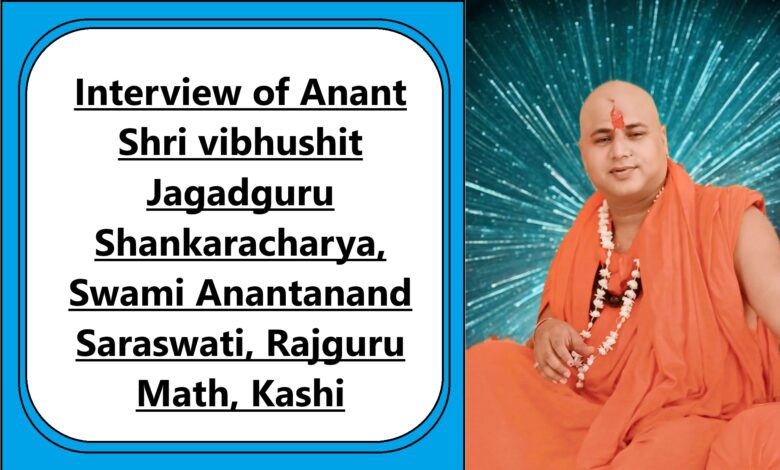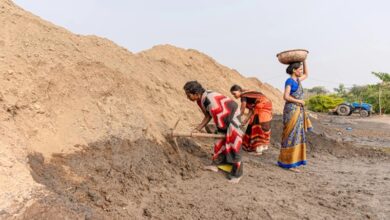Interview of Anant Shri vibhushit Jagadguru Shankaracharya, Swami Anantanand Saraswati, Rajguru Math, Kashi
Acharya Vyasanand Saraswati / 25th February 2025

@Swamiji … Can you give the brief of Mahakumbh -2025 ?
Answer: The Maha Kumbh Mela 2025 is currently underway in Prayagraj, Uttar Pradesh, running from January 13, to February 26, 2025. This event, held every 12 years, is one of the largest religious gatherings globally, drawing millions of pilgrims seeking spiritual purification at the confluence of the Ganga, Yamuna, and Saraswati rivers.
The 2025 Maha Kumbh Mela holds special significance due to a unique planetary alignment that occurs once every 144 years, making this gathering particularly auspicious.
The festival features several important bathing dates, known as “Amrit Snan” or royal baths, considered highly auspicious for devotees. These dates include:
- January 14, 2025 (Makara Sankranti): First Amrit Snan
- January 29, 2025 (Mauni Amavasya): Second Amrit Snan
- February 3, 2025 (Vasant Panchami): Third Amrit Snan
- February 12, 2025 (Magha Purnima): Important bathing day
- February 26, 2025 (Maha Shivaratri): Concluding bathing day
Unfortunately, the festival experienced a tragic incident on January 29, 2025, during the Mauni Amavasya celebrations. A pre-dawn stampede resulted in the loss of at least 30 lives and left 60 others injured. Despite this tragedy, the festival continues, with authorities implementing enhanced safety measures to manage the massive influx of devotees.
The Uttar Pradesh government, under the leadership of Prime Minister Narendra Modi, has undertaken extensive preparations to ensure a grand and spiritually enriching experience for all attendees. The event is expected to host over 400 million devotees throughout its 45-day duration, showcasing India’s rich cultural heritage and spiritual traditions.
For those planning to attend, it’s advisable to stay updated on official announcements and adhere to safety guidelines to ensure a fulfilling and secure experience at the Maha Kumbh Mela 2025.
The Purna Kumbh
Prun Kumbh Mela is a major Hindu pilgrimage and festival that takes place every 12 years at four sacred riverbank locations in India: Prayagraj (Allahabad), Haridwar, Ujjain, and Nashik. It is considered the largest religious gathering in the world.
Purpose of Mahakumbh Mela
- Spiritual Purification – Devotees believe that taking a holy dip in the sacred rivers during Mahakumbh washes away sins and leads to salvation (moksha).
- Religious Gathering – It brings together sadhus, saints, and pilgrims from all over India to discuss spiritual and religious teachings.
- Astrological Significance – The timing is based on specific planetary alignments, believed to enhance spiritual benefits.
- Social and Cultural Exchange – The festival fosters a sense of unity among people from diverse backgrounds.
- Renewal of Faith – Devotees participate in prayers, rituals, and discourses to strengthen their faith and devotion.
@Can you provide more details about its history, rituals?
Answer:
- History of Mahakumbh Mela
The origins of Mahakumbh Mela are deeply rooted in Hindu Sanskar, According to legend, the Samudra Manthan (churning of the ocean) between gods (Devas) and demons (Asuras) produced the Amrit (nectar of immortality). As the Devas tried to secure the Amrit, a divine battle ensued. During this battle, a few drops of Amrit spilled at four locations:
- Prayagraj (Allahabad) – Confluence of Ganga, Yamuna, and Saraswati
- Haridwar – River Ganga
- Ujjain – River Shipra
- Nashik – River Godavari
These places became sacred, and it is believed that bathing at these sites during Mahakumbh grants liberation (moksha).
- Types of Kumbh Melas
We have only two types of Kumbh, one is Ardha Kumbh and the other is Maha Kumbh. But from time to time, due to spiritual changes, names like Purna Kumbh and Maha Kumbh have also come up.
- Main Rituals of Mahakumbh Mela
- Shahi Snan (Royal Bath) – The most significant ritual where saints, sadhus, and pilgrims take a dip in the holy rivers at specific auspicious times.
- Satsangs & Pravachans – Spiritual discourses, chanting, and devotional singing take place.
- Darshan of Saints – People visit Akharas (monastic orders) to seek blessings from ascetics and sadhus.
- Pujas & Yajnas – Ritualistic worship and fire offerings for peace, prosperity, and purification.
- Processions of Naga Sadhus – The Naga Sadhus (naked monks) lead processions before the royal bath.
@Swamiji … say something about Hindu Sanatan Dhrama.
Answer: Sanātana Dharma, commonly known as Hinduism, is one of the world’s oldest spiritual traditions. The term Sanātana Dharma means “eternal duty” or “eternal order,” reflecting the belief that its principles are timeless and universal. It is not just a religion but a way of life that encompasses philosophy, ethics, rituals, and spiritual practices.
Sanātana Dharma is rooted in the Vedas, Upanishads, Bhagavad Gita, Ramayana, Mahabharata, and other sacred scriptures. It emphasizes Dharma (righteousness), Karma (action and its consequences), Moksha (liberation), and Bhakti (devotion). The diversity of deities, traditions, and philosophies within Hinduism reflects its inclusive and pluralistic nature.
Central to Sanātana Dharma is the idea that the divine manifests in many forms, and different paths—such as gyan Yoga (path of knowledge), Bhakti Yoga (path of devotion), Karma Yoga (path of selfless action), and Raja Yoga (path of meditation)—lead to the same ultimate truth. It teaches respect for all beings, the pursuit of self-realization, and harmony with the universe.
@Swamiji … Can you say something about Akhadas?
Answer: In Hindu Dharma, Akhadas (अखाड़ा) are traditional monastic and warrior orders primarily associated with sadhus (ascetics) and saints of the Dashanami Sampradaya founded by Adi Shankaracharya and the Naga Sadhus. These Akhadas serve as spiritual and martial institutions that uphold and protect Sanatan Dharma.
Types of Akhadas
Akhadas are broadly classified into three categories:
- Shaiva Akhadas – Dedicated to Lord Shiva and primarily consist of Naga Sadhus.
- Vaishnava Akhadas – Worshippers of Lord Vishnu and his avatars.
- Udasi Akhadas – Established by Guru Nanak’s disciple, Sri Chand, followed mainly by Sikh ascetics.
Major Shaiva Akhadas (Naga Sadhus)
These Akhadas train sadhus in spiritual knowledge, rituals, and sometimes in martial arts like wrestling and weaponry:
- Juna Akhada – The largest and most powerful, associated with Naga Sadhus.
- Mahanirvani Akhada – One of the oldest, founded by Adi Shankaracharya.
- Atal Akhada – Known for its strict ascetic practices.
- Avahan Akhada – Focuses on both spiritual learning and physical training.
- Anand Akhada
- Niranjani Akhada
- Agni Akhada – Known for Tantric and yogic practices.
Major Vaishnava Akhadas
These Akhadas focus on bhakti (devotion) and scriptures:
- Sri Panchayati Akhada (Nirmohi Ani)
- Sri Panchayati Akhada (Digambar Ani)
- Sri Panchayati Akhada (Bada Udasin udasin and nirmal)
Significance of Akhadas
- Preservation of Dharma – Act as guardians of Hindu traditions, rituals, and culture.
- Martial Training – Historically, they played a role in protecting temples and dharma.
- Spiritual Learning – Serve as training centers for renunciates in scriptures, meditation, and yoga.
- Kumbh Mela – Akhadas play a major role in the grand procession (Shahi Snan) during the Kumbh Mela, where Naga Sadhus are the first to take a holy dip in the sacred rivers.
@Swamiji … As you are Jagadguru, can you give some information about Adi Guru Shankaracharya
Answer: Adi Guru Shankaracharya (788–820 CE) was a great Indian philosopher, theologian, and spiritual leader who revitalized Hinduism by consolidating the Advaita Vedanta philosophy. He traveled across India, debating scholars and establishing four mathas (monastic centers) in different regions to preserve and promote Vedic traditions.
Shankaracharya emphasized the concept of Advaita (non-dualism), which teaches that the individual soul (Atman) and the supreme reality (Brahman) are one. His works include commentaries on the Upanishads, Bhagavad Gita, and Brahma Sutras, which remain foundational texts of Vedanta philosophy.
He is also credited with composing devotional hymns and organizing Hindu practices, reinforcing the importance of Jnana (knowledge) as the path to liberation (Moksha). His teachings continue to influence Hindu spirituality and philosophy today.
Adi Shankaracharya established four Mathas (monastic centers) in different regions of India to preserve and propagate Advaita Vedanta. Each Matha was assigned a Veda and a specific direction:
- Sringeri Sharada Peetham (South – Karnataka)
- Veda: Yajur Veda
- Deity: Goddess Sharada
- Located in Karnataka, it is the first matha established by Shankaracharya and a major center of Vedantic learning.
- Dwarka Sharada Peetham (West – Gujarat)
- Veda: Sama Veda
- Deity: Goddess Kali
- Situated in Dwarka, Gujarat, this matha upholds Advaita philosophy and fosters spiritual traditions in western India.
- Jyotir Math (Jyotir Peetham) (North – Uttarakhand)
- Veda: Atharva Veda
- Deity: Lord Badri Narayan
- Located near Badrinath, it is a key center for preserving Advaita teachings in the Himalayas.
- Govardhan Math (Govardhan Peetham) (East – Odisha)
- Veda: Rig Veda
- Deity: Lord Jagannath
- Based in Puri, Odisha, it plays a crucial role in upholding Hindu traditions in eastern India.
These Mathas continue to be important centers of Hindu philosophy and spiritual leadership.
These all four Maths were coming for the Gyan of Vedas in Kashi and this place is Rajguru Math, from which I belong to.
@Swamiji…. Can you say something about Bhartiya Sanskar ?
Answer: Bhartiya Sanskar refers to the traditional values, customs, and moral principles that form the cultural and ethical foundation of Indian society. Rooted in ancient scriptures like the Vedas, Upanishads, and epics such as the Ramayana and Mahabharata, these values emphasize virtues like respect for elders, devotion to family, hospitality, honesty, non-violence, and spiritual growth.
Key Aspects of Bhartiya Sanskar
- Respect and Obedience – Honoring parents, teachers (Guru), and elders.
- Dharma (Righteousness) – Leading a life based on ethical and moral principles.
- Samskara (Life Rituals) – 16 sacraments (Sanskaras) from birth to death, including Naamkaran (naming ceremony) and Vivah (marriage).
- Spirituality and Worship – Belief in God, meditation, yoga, and prayers.
- Compassion and Kindness – Helping others, practicing charity, and maintaining harmony.
- Self-Discipline – Practicing self-restraint, truthfulness, and hard work.
- Unity in Diversity – Respecting different religions, traditions, and perspectives.
These values help in shaping an individual’s character, promoting social harmony, and preserving India’s rich cultural heritage.
@ Swamiji … Say something about Hindu rituals
Hindu rituals are an integral part of the religion, deeply rooted in tradition, philosophy, and devotion. They can be classified into daily rituals (nitya karma), occasional ceremonies (naimittika karma), and personal spiritual practices (kamya karma).
Some common Hindu rituals include:
- Puja (Worship): Offering prayers, flowers, incense, and food to deities at home or temples.
- Aarti: A devotional song and light offering to God.
- Japa & Meditation: Chanting mantras or meditating to connect with the divine.
- Yajna (Fire Ritual): A Vedic tradition of making offerings to fire while chanting mantras.
- Sanskaras (Life-Cycle Rituals): Ceremonies marking key life stages like birth, initiation (Upanayana), marriage, and death rites (Antyeshti), that is 16 Sanskar.
- Festival Celebrations: Each Hindu festival, like Diwali, Holi, and Navaratri, has its own set of rituals and customs.
Hindu rituals are designed to foster discipline, devotion, and a sense of connection to the divine, nature, and community.
(This story has not been edited by News Mania staff and is published from a Media Release)






